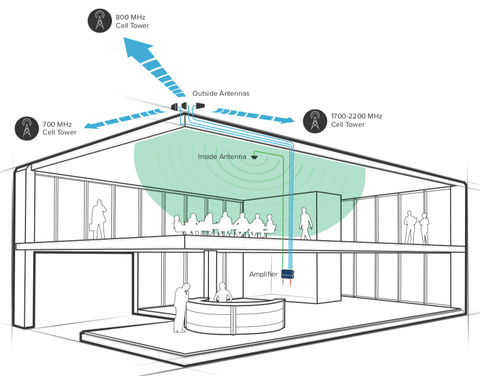Wilson Pro Multi-Tower Targeting Antenna Technology
Aug 08, 2019

Wilson Pro offers new multi-tower targeting antenna technology in WilsonPro 1300/1300R and 4300/4300R Enterprise cell phone signal booster models. With this new advancement, the main cellular amplifier unit has 3 exterior antenna ports for input of exterior signals. This solves the problem when outside signal is very weak and the cell towers of different carriers are located in different directions.
Earlier legacy systems only had a single port for exterior antenna with no capability to feed signals from different bands separately for maximum impact. All cellular booster systems had single outside antenna port for possibly pointing a directional Yagi or LPDA antenna in the direction of one carrier which would then become disadvantageous for interior coverage of another carrier with cell tower located in another direction.
These new commercial grade cell boosters thus have the flexibility of operating in traditional Common Mode, in which all amplifier cell bands use the same outdoor antenna, or Split Mode, in which cell bands use separate outdoor antennas. "Split Mode" is explained in more detail further below with a snapshot of the settings screen as it displays on an actual amplifier unit.
Adjustable settings on amplifier touchscreen:
Color LCD touch screen in both Wilson Pro Enterprise Signal Boosters 1300R/1300 and 4300R/4300 systems help assess booster performance, view amplifier configuration, and make adjustments. This easy-to-use colored LCD screen and all antenna ports are located on the same side of the unit, for easier installation.
Split Mode:
Split mode is advantageous for an installation in which cell towers for different bands are located in different directions. Multiple directional antennas on top of building can thus be pointed in different directions to provide maximum cell coverage for each band. See diagram shown above to help visualize this setting.
View an example of frequency-specific "split mode" option as it appears on the booster display, facilitating separate outdoor antennas for different bands, resulting in improved indoor coverage:

Common Mode:
Common mode can be used for an installation in which cell towers for different bands are located in the same direction. See sketch of installation setting shown at the very top, except with antenna pointing in single direction to help visualize this scenario. Wilson Pro amplifiers are configured to the common mode by default, and must be changed, if needed, to set to split mode.
Summary:
Typical construction materials for mid-sized and large buildings, such as metal and concrete, are notorious for impeding cell signal. The Wilson Pro Enterprise 1300/1300R and Enterprise 4300/4300R's multiple cell tower targeting technology offering multiple outdoor antenna ports provides best-in-class coverage. This Wilson Pro multi-tower targeting antenna technology in both WilsonPro Enterprise cell phone signal boosters makes these powerful amplifiers a natural choice for installers and integrators looking to provide reliable wireless telecommunication network signal for buildings up to 100,000 square feet. Furthermore, WilsonPro Enterprise signal boosters are stackable, meaning that multiple kits can be installed to boost in-building coverage to up to one million sq. ft.
WilsonPro Enterprise 1300 & 1300R Signal Booster MTT Details:
WilsonPro Enterprise 4300 & 4300R Signal Booster MTT Details:
WilsonPro Enterprise Signal Boosters 1300/R & 4300/R:
Share this post
4 comments



Here we see situations where even the most powerful cell boosters are ineffective without some adjustments. Wilson Pro’s multi-tower targeting antenna technology seems to have filled the gap for places where building materials weaken cell phone signals so much that even signal boosters couldn’t save the day.
When people ask me why they can’t get a good signal on their phone, I tell them to walk into a mall or Best Buy and see how bad things get. Then I explain how construction materials impede signals and make life miserable for anyone wanting to call out, text, or go online. This little article just reinforces my understanding of things.
I really dig the Wilson Pro Multi-Tower’s adjustable settings because every business has its own needs and requirements for its cell phone boosters. The fact you have multiple antennas to use and to adjust to meet your business’ requirements means a lot. I’d like to know if there are set-ups like this for residential boosters (probably for larger homes).
I’m not an electronics expert but I have learned a lot about cell phone boosters and the different ways you can use them in your car, home, or business when you’re having problems getting a steady signal. This particular Wilson Pro looks particularly promising for larger platforms because of the multiple antennas. I’ve wondered why they didn’t make these with more than one antenna so you could aim them at different areas to maximize range and improve your coverage. It seems this technology has finally caught up with people’s dreams for a better cell booster.